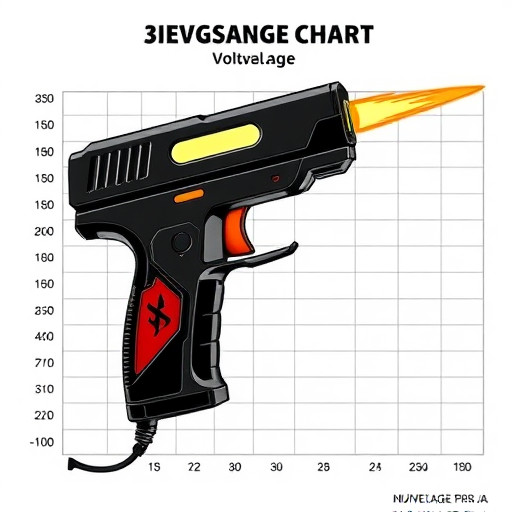A stun gun's effectiveness is gauged by its stun gun voltage chart which shows voltage output, ranging from 50,000-150,000 volts AC. While higher voltages can lead to faster immobilization, other factors like current, pulse width, device size, and design also impact performance. Users should consider their specific needs, local laws, and safety aspects when selecting a stun gun, aiming for consistent high voltage along with essential features and best practices for optimal effectiveness and minimal harm.
“Unraveling the power behind stun guns begins with understanding their voltage output. This comprehensive guide delves into the intricate details of stun gun voltage, offering a clear picture through our detailed Stun Gun Voltage Chart. We explore factors influencing their effectiveness and safety best practices to ensure informed decisions.
From voltage ranges to real-world applications, we simplify the process of choosing the ideal stun gun tailored to your needs. Discover the key metrics and insights that make navigating this market a breeze, all while staying ahead with our SEO-optimized Stun Gun Voltage Chart as your trusted reference.”
Understanding Stun Gun Voltage Output
Stun guns, also known as electronic control devices (ECDs), operate by delivering an electric shock to disrupt muscle control in the body, temporarily incapacitating the target. The key performance indicator in a stun gun is its voltage output, which represents the amount of electrical energy delivered per pulse. Understanding stun gun voltage output is crucial when assessing effectiveness and safety.
A stun gun voltage chart can provide valuable insights into different models’ capabilities. Typically, higher voltage outputs mean stronger jolts, potentially resulting in quicker immobilization. However, it’s essential to note that the human body’s tolerance varies, and factors like target size, muscle mass, and physical condition can influence the effectiveness of a stun gun shock. Therefore, when considering a stun gun purchase, evaluating its voltage output in conjunction with other features ensures you’re making an informed decision based on your specific needs and local legal requirements.
Stun Gun Voltage Chart: A Comprehensive Overview
A stun gun’s effectiveness is directly tied to its voltage output, making a stun gun voltage chart an essential tool for consumers. This chart provides a clear comparison of different models’ voltage ranges and their corresponding impact on targets. Typically, stun guns produce voltages ranging from 50,000 to 150,000 volts AC (or higher). Higher voltage doesn’t always translate to better performance; it depends on factors like current, pulse width, and the stun gun’s design.
When examining a stun gun voltage chart, look for models that offer consistent high voltage output while also considering other features like impact distance, safety mechanisms, and durability. This comprehensive overview allows users to make informed decisions based on their specific needs and preferences, ensuring they choose a stun gun that not only meets but exceeds industry standards for safety and efficacy.
Factors Affecting Stun Gun Effectiveness
The effectiveness of a stun gun isn’t solely determined by its power in terms of voltage. Several factors come into play when considering how well a stun device will perform during an encounter. One key aspect is the type and quality of the electrical current it delivers, which differs between stun guns using AC (alternating current) or DC (direct current). Additionally, the size, weight, and design of the stun gun impact its ease of use and concealment, influencing its overall effectiveness in real-world scenarios.
A stun gun voltage chart can provide a basic comparison, but it’s crucial to understand that voltage alone doesn’t guarantee success. The path of electric current through the body, muscle mass of the target, and their level of fear or surprise also play significant roles. Therefore, while high voltage might seem ideal, it’s the combination of these elements that truly determines how effectively a stun gun will disrupt an assailant’s movements.
Safety Considerations and Best Practices
When considering a stun gun, it’s paramount to understand safety considerations and best practices. Always refer to a stun gun voltage chart to ensure the device meets your needs while adhering to legal limits. Each stun gun is designed with a specific voltage output, crucial for neutralizing an attacker without causing permanent harm.
Best practices include familiarizing yourself with local laws regarding stun guns, as voltage restrictions vary by region. Regular maintenance and testing are essential; ensure the device is in optimal condition before each use. Additionally, proper training in self-defense techniques that incorporate stun guns enhances effectiveness and safety during an encounter.
Choosing the Right Stun Gun for Your Needs
When selecting a stun gun, understanding the voltage output is crucial. Stun guns are available in various voltage ranges, typically measured in thousands of volts (kV). A stun gun voltage chart can help users make informed decisions based on their specific needs and potential threats. For personal protection against single aggressors, lower voltage ranges (e.g., 30,000-50,000 kV) are often sufficient to incapacitate an attacker temporarily without causing severe harm.
However, for professional or advanced users facing more dangerous situations, such as close-quarters combat or multiple assailants, higher voltage models (e.g., 70,000-120,000 kV or more) might be more appropriate. These powerful stun guns deliver stronger jolts that can disrupt an attacker’s muscular control and coordination, providing users with the advantage they need in high-risk scenarios.
